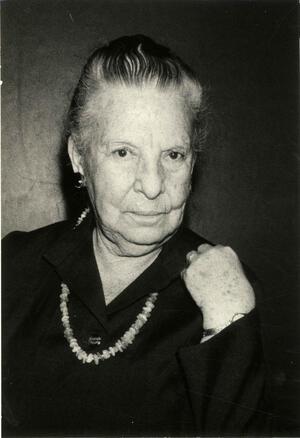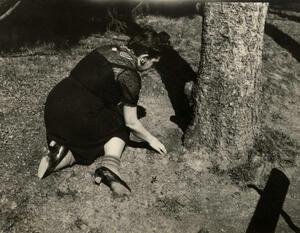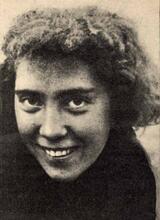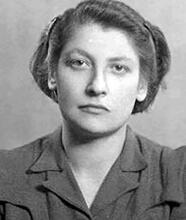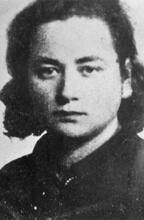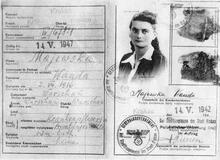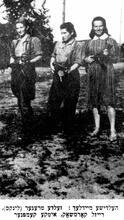Miriam Novitch
Originally from the Russian Empire, Miriam Novitch had a background in languages that helped her serve a key role in the French Resistance. Disguised as a Christian Russian tutor, she smuggled and distributed printed materials and publications, until she was caught in June 1943. While in the Vittel Internment Camp, she met the Polish poet Itzhak Katzenelson, who taught her about the Warsaw Ghetto Uprising and the Jewish Fighting Organization, begging her before he was deported East to preserve his memories and those of the other victims. She spent the rest of her life fulfilling his wish, helping to found the Ghetto Fighter’s House and collecting testimonies, documents, artworks, and artifacts from across Europe. She worked especially on the museum’s art collection, advocating for art as not just a historical resource but as a type of resistance in and of itself.
Early Life and Education
Miriam Novitch was born on March 1, 1908, in Yuratishki, then in the Russian Empire (now Belarus), daughter of Batja Chlawnowicz and Mosze–Yacow Chlawnowicz, a wood merchant. She had two brothers, Yossef and Shim'on. Her mother passed away when she was a child and her father encouraged her to study. The family moved to Vilna (then in Poland, now Lithuania), where she graduated from the Jewish high school.
Novitch wished to be a teacher of languages, but due to the numerus clausus in Poland limiting the number of Jewish students in universities, she moved to France in the mid-1920s. In Paris she was certified as a teacher of Russan and German. Over the years, she also mastered French, Italian, English, and Hebrew, alongside her mother tongue of Yiddish. While in Paris, she identified as a communist and changed her name to Maria, returning to the name Miriam later in life.
World War II Resistance
During World War II, Novitch joined the French Resistance. Her activities focused on smuggling printed materials and distributing the underground’s publications. Disguised as a Christian Russian, she worked as a Russian tutor; one of her students was an SS man. Under this guise, she passed information on to the underground. She also acquired documents for Jews and helped them find hiding places in villages.
On June 10, 1943, Novitch was arrested by the Gestapo in a small town outside Paris. After two months, she was transferred to the Vittel internment camp. In Vittel she met the poet Itzhak Katzenelson (1886-1944), who was arrested there with his son Zvi after having been deported from Poland. During their conversations, Katznelson taught Novitch Talmudic legends and spoke about the poems of Shaul Tchernichovsky and Hayim Nahman Bialik. He also told her about the Warsaw Ghetto and the Jewish resistance there and about the Jewish Fighting Organization (Zidowska Organizacja Bojowa, or ZOB). Katzenelson read her poems he wrote in Vittel, including “The Song of the Murdered Jewish People.” She helped him to seal a manuscript of “The Song of the Murdered Jewish People” in a container and bury it in an agreed-upon spot in order to be able to find it after the war. Novitch later brought the manuscript to Israel.
Novitch was fascinated by Katzenelson. She later said that before he was deported to the East in 1944, he told her: “Keep the memory! Do not let people forget what was done here. Build memorials, arrange exhibitions, open libraries—in memory of those who were taken like lambs to the slaughter!” (Adiv). Novitch’s biographer, Zvika Dror, wrote that in retrospect it became clear to Novitch that “Itzhak Katzenelson converted [her] to Zionism.” From that point, she devoted her life to his wish, collecting documents and testimonies during the war and from Holocaust survivors after the war.
Documenter and Curator
In 1946 Novitch published her first book, The Right to a Homeland (Le droit à la patrie), under the pseudonym Miriam Bat-Ami. That year in Paris she met Zivia Lubetkin and Yitzhak Zuckermann, leaders of the ZOB in the Warsaw Ghetto with whom she was familiar from Katznelson’s stories; in part because of their relationship, she decided to immigrate to Eretz-Yisrael. She then joined Kibbutz Lohamei HaGeta'ot.
Novitch was wone of the founders of the Itzhak Katzenelson Holocaust and Jewish Resistance Heritage Museum, also known as the Ghetto Fighters’ House, and worked there as a documenter, researcher, and curator. She represented the GFH while travelling in Europe collecting documents, films, artworks, and artifacts. She visited archives, film libraries, research institutes, and government and public establishments in Poland, Germany, Austria, Czechoslovakia, France, England, Norway, Belgium, the Netherlands, Luxembourg, Spain, Portugal, Italy, and Switzerland; she also travelled also to Yugoslavia and Greece to collect testimonies form survivors. In 1960 she was one of the GFH workers who provided materials to “Bureau 06,” the Israeli Police special unit tasked with preparing the State of Israel’s charges against Adolf Eichmann for his 1961 trial in Jerusalem.
Novitch initiated the GFH’s art collection and served as its first curator. She also initiated and curated exhibitions in Eilat, Tel Aviv, Haifa and Holon. In Novitch’s eyes, artworks, such as paintings and photos, are tremendous historical resources, especially for the Holocaust. Furthermore, she saw art as an act of resistance in and of itself. In testimony she gave to Zvika Dror, she explained art’s significance as a form of resistance: “in almost every concentration camp there were instances of spiritual resistance, in spite of shortage and distress—in poetry, in painting, in play.”
In Israel, Novitch’s activism was considered vital to Holocaust documentation and commemoration. A journalist who interviewed her in 1960 wrote that Novitch was “the ambassador of a murdered generation” in Israel (Ha-elion).
Personal Life
Novitch was married for a short time to the painter Moshe Kastel (1909—1991) and their son Bob (Baruch) was born in 1937. During the war, she adopted a baby girl in Vittel she named Batya. Both children immigrated to Eretz-Yisrael and grew up far from Novitch.
Despite her intensive documentary work, Novitch never documented her own story. When she gave testimony to Dror for his project Testimony of Survival, she said: “I have no biography. Until 1939, this was a piece of life I have long left behind, and after 1939, the years passed in a flash. I devoted them to one purpose: ‘Never to forget!’”
Novitch passed away on April 15, 1990, and was buried one day after the 46th anniversary of her last meeting with Katzenelson in the Vittel camp and one day before the 41st anniversary of the establishment of Kibbutz Lohamei HaGeta'ot.
Selected Works by Miriam Novitch
[Bath-Ami, Miriam.] Le droit à la patrie: Témoignages sur les massacres en Pologne. Paris: L. Rodstein, 1946. (French)
La vérité sur Treblinka. Israel: Beth Lohamei-Haghettaoth, 1967. (French)
Le genocide des Tziganes sous le regime Nazi. Paris: Montbrun, 1968. (French)
Sobibor: Martyrdom and Revolt: Documents and Testimonies. New York: Holocaust Library, 1980. (in French 1978, in Hebrew 1979]
With Lucy S. Dawidowicz and Tom L. Freudenheim. Spiritual Resistance: Art from Concentration Camps 1940-1945: A Selection of Drawing and Paintings from the Collection of Kibbutz Lohamei Haghetot, Israel. Philadelphia: Jewish Publication Society of America, 1981. (Hebrew)
The Passage of the Barbarians: Contribution to the History of the Deportation and Resistance of Greek Jews. Hull: Glenvil Group, 1989.
Adiv, Rachel. “Matzevet hasho'ah vehamered.” [Memorial of the Holocaust and the Uprising]. Dvar ha-poelet 24 (1960): 76-77. (Hebrew)
Dror, Zvika. Miriam's Burden: The Life of Miriam Novitch. Israel: The Ghetto Figthers House and Kibbutz oḥamei ha-Geṭaʼot, 2008. (Hebrew)
Dror, Zvika (Interviewer and editor). “Miriam Novitch.” Testimonies of Survival: 96 Personal Interviews from the members of Kibbutz Lochamei Hageta'ot. Vol. 2, Tel Aviv: Hakibbutz Hameuchad. 1984, pp. 499—518. (Hebrew)
Geva, Sharon. “‘To Collect the Tears of the Jewish People’: The Story of Miriam Novitch.” Holocaust Studies 21, no. 1–2 (2015): 73–92.
Geva, Sharon. To the Unknown Sister: Holocaust Heroines in Israeli Society. Tel Aviv Hakibbutz Hameuchad, 2010 (Hebrew).
Ha-elion, Ya’akov. “Hashagrira shel dor ha'hashmada.” [Ambassador of the Murdered Generation] Maariv. May 3, 1960. (Hebrew)
The estate of Miriam Novitch: personal documents. 38956. The Ghetto Fighters’ House Archives.

